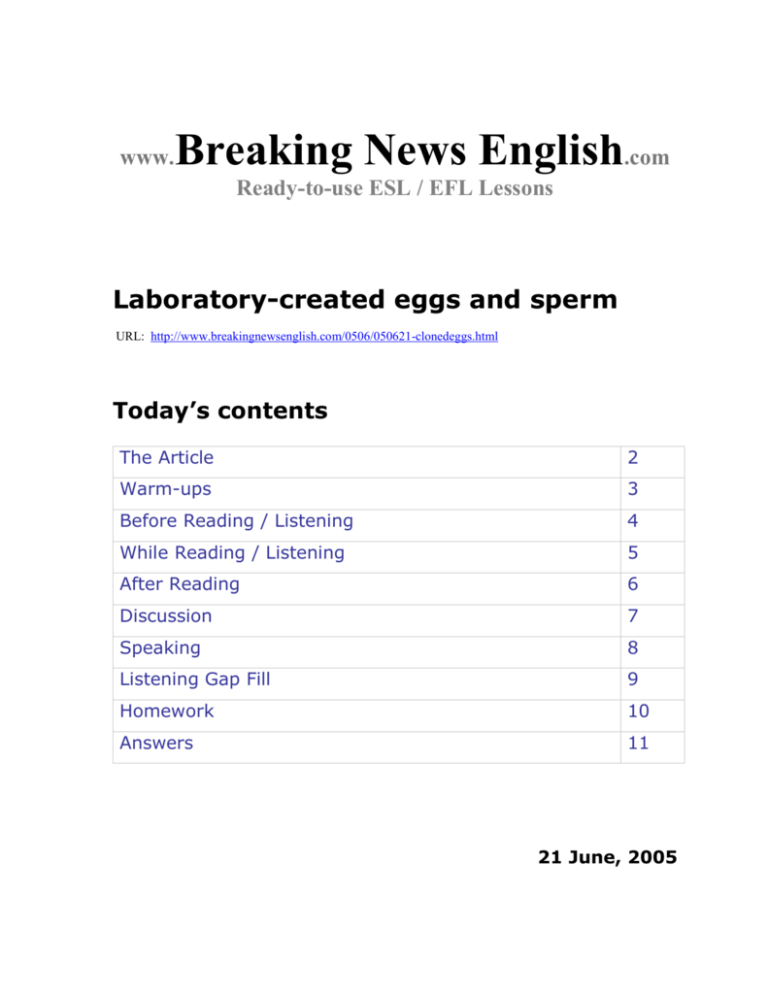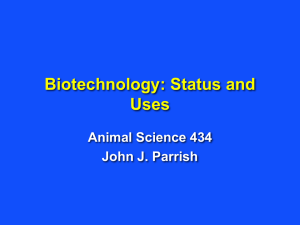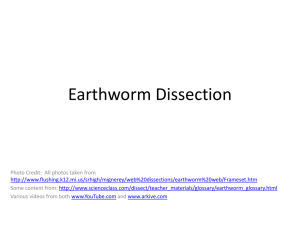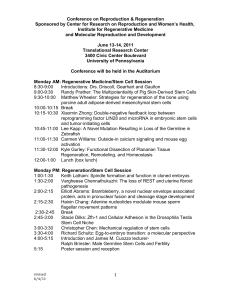Laboratory-created eggs and sperm
advertisement

www. Breaking News English.com Ready-to-use ESL / EFL Lessons Laboratory-created eggs and sperm URL: http://www.breakingnewsenglish.com/0506/050621-clonedeggs.html Today’s contents The Article 2 Warm-ups 3 Before Reading / Listening 4 While Reading / Listening 5 After Reading 6 Discussion 7 Speaking 8 Listening Gap Fill 9 Homework 10 Answers 11 21 June, 2005 Laboratory-created eggs and sperm – 21 June, 2005 THE ARTICLE Laboratory-created eggs and sperm BNE: British scientists at the University of Sheffield Center for Stem Cell Biology (CSCB) have announced that it may one day be possible to clone human eggs and sperm from stem cells. This means the entire process of human conception could take place in a science laboratory. It would revolutionize fertility treatments for couples unable to have children of their own. It would also enable same sex couples to have children that shared the genetic code of both partners. A further benefit would be to replenish current shortages of egg and sperm stocks from donors. Childless couples in Britain are part of a “fertility tourism” trend of seeking reproductive assistance overseas. The CSCB website* quoted British Fertility Society secretary Dr. Allan Pacey, who described the research as an “exciting step forward”. Dr. Pacey said the latest findings have “huge implications for the way we could undertake research studies to investigate the processes of egg and sperm development.” He said we were still in the early stages of fully understanding the biology of conception: “We still don’t really understand why some men and women can’t produce sperm and eggs of their own, and sadly for them that leads to infertility.” He optimistically stated that science is a step closer to unraveling the mysteries of life. *University of Sheffield Centre for Stem Cell Biology http://cscb.shef.ac.uk/News/Article275.htm Find this and similar lessons at http://www.BreakingNewsEnglish.com 2 Laboratory-created eggs and sperm – 21 June, 2005 WARM-UPS 1. CLONING: Talk to your partner(s) about how far science should go with cloning and reproducing cells, life or body parts. Should research on cloning be allowed? Is it OK to clone animals and humans? Are scientists playing the role of God? Are scientists close to producing a Frankenstein’s monster? Write down five reasons why cloning is a good or a bad thing. Change partners and explain your reasons. 2. CHAT: In pairs / groups, decide which of these topics or words are most interesting and which are most boring. Scientists / stem cells / stem cell research / human conception / human eggs / sperm / same sex parents / childless couples / fertility tourism / the mysteries of life 3. BIOLOGY: Spend one minute writing down all of the different words you associate with the word “biology”. Share your words with your partner(s) and talk about them. Together, put the words into different categories. 4. TWO-MINUTE CLONED EGG DEBATES: With a partner, engage in these fun 2-minute debates. Students A firmly believe in the opinions on the left, Students B support the opinions on the right. Change partners often. a. b. c. d. e. Cloning is wrong. vs. Cloning is part of scientific research. Cloning is dangerous. vs. Scientists know what they are doing. Stem cell fertility is great news for childless couples. vs. There are other ways. Human egg cloning is great news for same sex couples. vs. It’s totally unnatural. Anyone will soon be able to have children. vs. The world is already overpopulated. f. It is unethical to create and then destroy life. vs. A fertilized egg isn’t a person. g. Scientists will change the human race. vs. Scientists will improve the human race. h. I want to be cloned. vs. The thought of a cloned me is too terrible to think about. 5. BENEFICIAL CLONING: Talk about in which of these situations is it OK to use stem cells or cloning techniques: a. To enable childless couples to start their own family. b. So scientists can have a supply of embryos to use for research into deadly diseases. c. To resurrect extinct animal and bird species. d. To enable same sex couples to have children that are a genetic match of both partners. e. To grow replacement body parts for use in life-saving transplants. f. To make sure your children look identical to you. g. As an emergency measure to increase the population in underpopulated countries. h. Other. Find this and similar lessons at http://www.BreakingNewsEnglish.com 3 Laboratory-created eggs and sperm – 21 June, 2005 BEFORE READING / LISTENING 1. TRUE / FALSE: Look at the article’s headline and guess whether these sentences are true (T) or false (F): a. b. c. d. e. f. g. h. Scientists can use chemicals to reproduce human eggs and sperm. The process from conception to birth could take place in a lab. Two men could provide the genetic code for their own baby. Fertility tourism is popular with childless British couples. A British fertility expert angrily criticized the new research. The findings have huge implications for understanding our biology. Scientists understand everything about infertility. Scientists say we’ll never understand the mysteries of life. T/F T/F T/F T/F T/F T/F T/F T/F 2. SYNONYM MATCH: Match the following synonyms from the article: a. b. c. d. e. f. g. h. i. j. announced conception genetic code replenish trend described implications investigate infertility unraveling ramifications refill fad outlined origin probe sterility made public figuring out DNA 3. PHRASE MATCH: Match the following phrases from the article (sometimes more than one combination is possible): it may one day human c. fertility d. same sex e. replenish current f. huge g. undertake h. the biology i. that leads j. unraveling a. b. treatments to infertility couples research studies be possible the mysteries of life implications conception shortages of conception Find this and similar lessons at http://www.BreakingNewsEnglish.com 4 Laboratory-created eggs and sperm – 21 June, 2005 WHILE READING / LISTENING WHICH WORD?: Circle the correct word in each of the pairs in italics. Laboratory-created eggs and sperm BNE: British scientists at the University of Sheffield Center for Stem Cell Biology (CSCB) have announced / denounced that it may one day be possible to clone human eggs and spam / sperm from stem / twig cells. This means the entire process of human perception / conception could take place in a science laboratory. It would revolutionize fertility treatments for couplets / couples unable to have children of their own. It would also enable same sex couples to have children that shared / shaped the genetic code of both partners. A further benefit would be to replicate / replenish current shortages of egg and sperm stocks from donors. Childless couples in Britain are part of a “fertility tourism / sightseeing” trend of seeking reproductive assistance overseas. The CSCB website quoted / quotation British Fertility Society secretary Dr. Allan Pacey, who described / inscribed the research as an “exciting step forward”. Dr. Pacey said the earliest / latest findings have “huge implications for the way we could overtake / undertake research studies to investigate the production / processes of egg and sperm development.” He said we were still in the early / primordial stages of fully understanding the biology of conception: “We still don’t really understand why some men and women can’t produce sperm and eggs of their own, and sadly for them that leads to impotence / infertility.” He optimistically stated that science is a step closer to sealing / unraveling the mysteries of life. Find this and similar lessons at http://www.BreakingNewsEnglish.com 5 Laboratory-created eggs and sperm – 21 June, 2005 AFTER READING / LISTENING 1. WORD SEARCH: Look in your dictionaries / computer to find collocates, other meanings, information, synonyms … for the words ‘stem’ and ‘cell’. Share your findings with your partners. Make questions using the words you found. Ask your partner / group your questions. 2. ARTICLE QUESTIONS: Look back at the article and write down some questions you would like to ask the class about the text. Share your questions with other classmates / groups. Ask your partner / group your questions. 3. WHICH WORD?: In pairs / groups, compare your answers to this exercise. Check your answers. Talk about the relationships between the correct and incorrect words from the activity. 4. VOCABULARY: Circle any words you do not understand. In groups, pool unknown words and use dictionaries to find their meanings. 5. STUDENT STEM CELL SURVEY: In pairs / groups, write down questions about stem cells, ethics, playing God, etc. Ask other classmates your questions and note down their answers. Go back to your original partner / group and compare your findings. Make mini-presentations to other groups on your findings. 6. TEST EACH OTHER: Look at the words below. With your partner, try to recall exactly how these were used in the text: one day secretary conception implications revolutionize early stages genetic code biology replenish infertility tourism unraveling Find this and similar lessons at http://www.BreakingNewsEnglish.com 6 Laboratory-created eggs and sperm – 21 June, 2005 DISCUSSION STUDENT A’s QUESTIONS (Do not show these to student B) a. What did you think this article was about when you saw the headline? b. Did the headline make you want to read on? c. Are you interested in stem cell research and cloning? d. Do you know what stem cells are? e. Do you think there’s a difference between stem cell research and cloning? f. What do you think of the term “fertility tourism”? g. Do you think scientists are now playing the role of God? h. Do you think cloning will irreversibly change human beings? i. Do the benefits outweigh the dangers in this kind of research? j. Will this change the teaching of the birds and the bees at school? STUDENT B’s QUESTIONS (Do not show these to student A) a. b. c. d. e. f. g. Did you like reading this article? What did you think about what you read? Are you happy this research is being carried out? What do you think of the idea of scientists making babies? What do you think of the idea of babies from same sex couples? Would you like there to be a clone of yourself? Does a cloned egg that has been fertilized using cloned sperm represent real human life? h. Would you have a transplant using an organ that has been grown from stem cells? i. Do you think babies will be born in the future without the need for women to carry them in their wombs? j. Did you like this discussion? AFTER DISCUSSION: Join another partner / group and tell them what you talked about. a. b. c. d. e. f. g. What question would you like to ask about this topic? What was the most interesting thing you heard? Was there a question you didn’t like? Was there something you totally disagreed with? What did you like talking about? Do you want to know how anyone else answered the questions? Which was the most difficult question? Find this and similar lessons at http://www.BreakingNewsEnglish.com 7 Laboratory-created eggs and sperm – 21 June, 2005 SPEAKING FUTURE HUMANS: In pairs / groups, decide on the desirability (1 = highly undesirable, 10 = highly desirable) of the options listed in the table. These options may one day be part of our everyday lives. Write down some advantages and disadvantages for each option. Decide whether you would be interested in the options. OPTIONS 1 - 10 ADVANTAGES DISADVANTAGES Clones of living people. Clones of dead people. Choice of baby’s IQ, height, eye color, etc. Reproducing human organs for transplants. A “home shopping” baby production center. Same sex couples having their own babies. Change partners and share what you discussed with your previous partner(s). Return to your original partner(s) and talk about the things you heard that were (1) shocking, (2) very interesting, (3) totally crazy, (4) thought provoking, (5) mind blowing or any other adjective you choose. Find this and similar lessons at http://www.BreakingNewsEnglish.com 8 Laboratory-created eggs and sperm – 21 June, 2005 LISTENING Listen and fill in the spaces. Laboratory-created eggs and sperm BNE: British scientists at the University of Sheffield Center for ____ ____ _______ (CSCB) have announced that it may one day be possible to clone _____ ____ __ _____ from stem cells. This means the entire process of human _________ could take place in a science laboratory. It would revolutionize _________ __________ for couples unable to have children of their own. It would also enable same sex couples to have children that ______ ___ _______ code of both partners. A further benefit would __ __ _________ current shortages of egg and sperm stocks from donors. Childless couples in Britain are part of a “_________ ________” _____ of seeking reproductive assistance overseas. The CSCB website quoted British _________ _______ ________ Dr. Allan Pacey, who described the research as an “exciting step forward”. Dr. Pacey said the latest findings have “____ ____________ ___ the way we could undertake research studies to __________ ___ _________ __ egg and sperm development.” He said we were still in the early stages of fully understanding the ________ __ ___________: “We still don’t really understand why some men and women can’t produce sperm and eggs of their own, and sadly for them that _____ __ __________.” He optimistically stated that science is a step closer to __________ ___ __________ of life. Find this and similar lessons at http://www.BreakingNewsEnglish.com 9 Laboratory-created eggs and sperm – 21 June, 2005 HOMEWORK 1. VOCABULARY EXTENSION: Choose several of the words from the text. Use a dictionary or Google’s search field (or another search engine) to build up more associations / collocations of each word. 2. STEM CELL EGGS AND SPERM: Search the Internet and find more information on the latest in stem cell research and human reproduction. Share your findings with your class in the next lesson. 3. HUMAN FUTURE: Imagine you are a science fiction writer. Write a short essay on what our future will look like. Will we be living among clones? Will everyone look beautiful and be highly intelligent? Explain the main points of your essay to your classmates in your next lesson. Did everyone imagine a similar future? 4. LETTER: Write a letter to the scientists pioneering this research. Explain your views on what they are doing. Read your letter to your classmates in the next lesson. Did you all write about similar things? Find this and similar lessons at http://www.BreakingNewsEnglish.com 10 Laboratory-created eggs and sperm – 21 June, 2005 ANSWERS TRUE / FALSE: a. F b. F c. T d. T e. F f. T g. F h. F SYNONYM MATCH: a. announced made public b. conception origin c. genetic code DNA d. replenish refill e. trend fad f. described outlined g. implications ramifications h. investigate probe i. infertility sterility j. unraveling figuring out PHRASE MATCH: a. it may one day be possible b. human conception c. fertility treatments d. same sex couples e. replenish current shortages f. huge implications g. undertake research studies h. the biology of conception i. that leads to infertility j. unraveling the mysteries of life WHICH WORD?: Laboratory-created eggs and sperm BNE: British scientists at the University of Sheffield Center for Stem Cell Biology (CSCB) have announced that it may one day be possible to clone human eggs and sperm from stem cells. This means the entire process of human conception could take place in a science laboratory. It would revolutionize fertility treatments for couples unable to have children of their own. It would also enable same sex couples to have children that shared the genetic code of both partners. A further benefit would be to replenish current shortages of egg and sperm stocks from donors. Childless couples in Britain are part of a “fertility tourism” trend of seeking reproductive assistance overseas. The CSCB website quoted British Fertility Society secretary Dr. Allan Pacey, who described the research as an “exciting step forward”. Dr. Pacey said the latest findings have “huge implications for the way we could undertake research studies to investigate the processes of egg and sperm development.” He said we were still in the early stages of fully understanding the biology of conception: “We still don’t really understand why some men and women can’t produce sperm and eggs of their own, and sadly for them that leads to infertility.” He optimistically stated that science is a step closer to unraveling the mysteries of life. Find this and similar lessons at http://www.BreakingNewsEnglish.com 11




